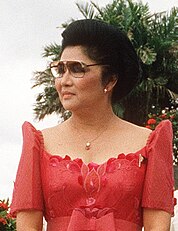
Back Elecciones presidenciales de Filipinas de 1992 Spanish Pemilihan umum Presiden Filipina 1992 ID Elezioni presidenziali nelle Filippine del 1992 Italian
| |||||||||||||||||||||||||||||||||||||||||||||||||||||
| Turnout | 75.5% ( | ||||||||||||||||||||||||||||||||||||||||||||||||||||
|---|---|---|---|---|---|---|---|---|---|---|---|---|---|---|---|---|---|---|---|---|---|---|---|---|---|---|---|---|---|---|---|---|---|---|---|---|---|---|---|---|---|---|---|---|---|---|---|---|---|---|---|---|---|
| |||||||||||||||||||||||||||||||||||||||||||||||||||||
 Election results per province/city. | |||||||||||||||||||||||||||||||||||||||||||||||||||||
| |||||||||||||||||||||||||||||||||||||||||||||||||||||
1992 Philippine vice presidential election | |||||||||||||||||||||||||||||||||||||||||||||||||||||
| |||||||||||||||||||||||||||||||||||||||||||||||||||||
| |||||||||||||||||||||||||||||||||||||||||||||||||||||
 Election results per province/city | |||||||||||||||||||||||||||||||||||||||||||||||||||||
| |||||||||||||||||||||||||||||||||||||||||||||||||||||
 |
|---|
|
|
The 1992 Philippine presidential and vice presidential elections were held on May 11, 1992.[1] This was the first general election held under the 1987 Constitution. An estimated 80,000 candidates ran for 17,000 posts from the presidency down to municipal councilors.
The new constitution limited the president to a single six-year term with no possibility of reelection, even if nonsuccessive.[2] Although some of President Corazon Aquino's advisers suggested that she could run for a second term,[3] as she was sworn in before the 1987 Constitution took effect, Aquino did not run again.[4]
In the presidential election, retired general Fidel Ramos of Lakas–NUCD narrowly defeated populist candidate Miriam Defensor Santiago of the People's Reform Party.[5] Ramos also got the lowest plurality in the Philippine electoral history, and beat the previous election for the closest margin of victory, percentage-wise (this record would later be beaten by the 2004 election).[6]
Santiago led the canvassing of votes for the first five days but then was overtaken by Ramos in a few days. Santiago cried fraud and filed an electoral protest citing power outages as evidence.[7] Various media personnel became witnesses to the fraud made in the election, where the phrase, 'Miriam won in the election, but lost in the counting' became popular.[8] However, her protest was eventually dismissed by the Supreme Court of the Philippines.[7]
The 1992 election was the second time both president and vice president came from different parties.[9] Movie actor and Senator Joseph Estrada, running with presidential candidate Eduardo Cojuanco, won a six-year term as vice-president.[10]
Under the transitory provisions of the Constitution, 24 senators were elected in this election. The first 12 senators who garnered the highest votes would have six-year terms while the next 12 senators would have three-year terms.[11] Laban ng Demokratikong Pilipino (LDP) received a large share in the Senate race.[12] Television personality and Quezon City vice mayor Vicente Sotto III (also known as Tito Sotto) received the highest number of votes.[13]
- ^ "Phl presidential elections and the stock market". The Philippine Star. Retrieved November 8, 2018.
- ^ "The 1987 Constitution of the Republic of the Philippine – Article VII". Official Gazette of the Republic of the Philippines. Retrieved November 8, 2018.
- ^ Jurado, Emil P. (25 July 1988). "Realignment of forces". Manila Standard. Retrieved November 8, 2018 – via Google News Archive.
- ^ Shenon, Philip. "Aquino Endorses Ex-Army Chief in Vote". Retrieved November 8, 2018.
- ^ "Ramos Is Declared New President 6 Weeks After Philippine Election". Retrieved November 8, 2018.
- ^ Singh, Daljit; Salazar, Lorraine Carlos (2006). Southeast Asian Affairs 2006. Institute of Southeast Asian Studies. p. 227. ISBN 9789812303738.
closest margin win 2004 election philippines.
- ^ a b Servando, Kristine F. "Miriam: I was cheated, but didn't call for people power". ABS-CBN News. Retrieved November 8, 2018.
- ^ Wolfgang, Sachsenroeder (2018-05-30). Power Broking In The Shade: Party Finances And Money Politics In Southeast Asia. World Scientific. ISBN 9789813230750.
- ^ "Single ticket: How about voting for president and VP together?". Rappler. Retrieved November 8, 2018.
- ^ "Erap presidency redux". The Philippine Star. Retrieved November 8, 2018.
- ^ "Term of Office of Senators". senate.gov.ph. Retrieved November 8, 2018.
- ^ Banks, Arthur S.; Day, Alan J.; Muller, Thomas C. (February 1, 2016). Political Handbook of the World 1998. Springer. ISBN 9781349149513.
- ^ "Senators Profile - Vicente C. Sotto III". www.senate.gov.ph. Retrieved November 8, 2018.










